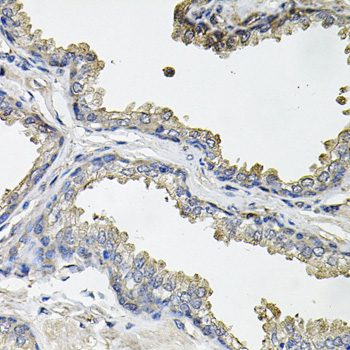Metabolism Antibodies 2
Anti-IREB1 Antibody (CAB7867)
- SKU:
- CAB7867
- Product Type:
- Antibody
- Reactivity:
- Human
- Reactivity:
- Mouse
- Reactivity:
- Rat
- Host Species:
- Rabbit
- Isotype:
- IgG
- Antibody Type:
- Polyclonal Antibody
- Research Area:
- Metabolism
Description
| Antibody Name: | Anti-IREB1 Antibody |
| Antibody SKU: | CAB7867 |
| Antibody Size: | 20uL, 50uL, 100uL |
| Application: | WB IHC |
| Reactivity: | Human, Mouse, Rat |
| Host Species: | Rabbit |
| Immunogen: | Recombinant fusion protein containing a sequence corresponding to amino acids 1-170 of human IREB1 (NP_002188.1). |
| Application: | WB IHC |
| Recommended Dilution: | WB 1:500 - 1:2000 IHC 1:50 - 1:100 |
| Reactivity: | Human, Mouse, Rat |
| Positive Samples: |
| Immunogen: | Recombinant fusion protein containing a sequence corresponding to amino acids 1-170 of human IREB1 (NP_002188.1). |
| Purification Method: | Affinity purification |
| Storage Buffer: | Store at -20'C. Avoid freeze / thaw cycles. Buffer: PBS with 0.02% sodium azide, 50% glycerol, pH7.3. |
| Isotype: | IgG |
| Sequence: | MSNP FAHL AEPL DPVQ PGKK FFNL NKLE DSRY GRLP FSIR VLLE AAIR NCDE FLVK KQDI ENIL HWNV TQHK NIEV PFKP ARVI LQDF TGVP AVVD FAAM RDAV KKLG GDPE KINP VCPA DLVI DHSI QVDF NRRA DSLQ KNQD LEFE RNRE RFEF LKWG SQAF HNMR II |
| Gene ID: | 48 |
| Uniprot: | P21399 |
| Cellular Location: | Cytoplasm |
| Calculated MW: | 98kDa |
| Observed MW: | Refer to figures |
| Synonyms: | ACO1, ACONS, HEL60, IREB1, IREBP, IREBP1, IRP1 |
| Background: | The protein encoded by this gene is a bifunctional, cytosolic protein that functions as an essential enzyme in the TCA cycle and interacts with mRNA to control the levels of iron inside cells. When cellular iron levels are high, this protein binds to a 4Fe-4S cluster and functions as an aconitase. Aconitases are iron-sulfur proteins that function to catalyze the conversion of citrate to isocitrate. When cellular iron levels are low, the protein binds to iron-responsive elements (IREs), which are stem-loop structures found in the 5' UTR of ferritin mRNA, and in the 3' UTR of transferrin receptor mRNA. When the protein binds to IRE, it results in repression of translation of ferritin mRNA, and inhibition of degradation of the otherwise rapidly degraded transferrin receptor mRNA. The encoded protein has been identified as a moonlighting protein based on its ability to perform mechanistically distinct functions. Alternative splicing results in multiple transcript variants |
| UniProt Protein Function: | IREB1: Iron sensor. Binds a 4Fe-4S cluster and functions as aconitase when cellular iron levels are high. Functions as mRNA binding protein that regulates uptake, sequestration and utilization of iron when cellular iron levels are low. Binds to iron-responsive elements (IRES) in target mRNA species when iron levels are low. Binding of a 4Fe-4S cluster precludes RNA binding. Belongs to the aconitase/IPM isomerase family. |
| UniProt Protein Details: | Protein type:EC 4.2.1.3; Carbohydrate Metabolism - citrate (TCA) cycle; Carbohydrate Metabolism - glyoxylate and dicarboxylate; RNA-binding; Lyase; Endoplasmic reticulum; Translation Chromosomal Location of Human Ortholog: 9p21.1 Cellular Component: cytoplasm; cytosol; endoplasmic reticulum; Golgi apparatus; mitochondrion Molecular Function:4 iron, 4 sulfur cluster binding; aconitate hydratase activity; iron-responsive element binding; protein binding; RNA binding Biological Process: citrate metabolic process; response to iron(II) ion |
| NCBI Summary: | The protein encoded by this gene is a bifunctional, cytosolic protein that functions as an essential enzyme in the TCA cycle and interacts with mRNA to control the levels of iron inside cells. When cellular iron levels are high, this protein binds to a 4Fe-4S cluster and functions as an aconitase. Aconitases are iron-sulfur proteins that function to catalyze the conversion of citrate to isocitrate. When cellular iron levels are low, the protein binds to iron-responsive elements (IREs), which are stem-loop structures found in the 5' UTR of ferritin mRNA, and in the 3' UTR of transferrin receptor mRNA. When the protein binds to IRE, it results in repression of translation of ferritin mRNA, and inhibition of degradation of the otherwise rapidly degraded transferrin receptor mRNA. The encoded protein has been identified as a moonlighting protein based on its ability to perform mechanistically distinct functions. Alternative splicing results in multiple transcript variants [provided by RefSeq, Jan 2014] |
| UniProt Code: | P21399 |
| NCBI GenInfo Identifier: | 3123225 |
| NCBI Gene ID: | 48 |
| NCBI Accession: | P21399.3 |
| UniProt Secondary Accession: | P21399,Q14652, Q5VZA7, D3DRK7, |
| UniProt Related Accession: | P21399 |
| Molecular Weight: | 98,399 Da |
| NCBI Full Name: | Cytoplasmic aconitate hydratase |
| NCBI Synonym Full Names: | aconitase 1 |
| NCBI Official Symbol: | ACO1 |
| NCBI Official Synonym Symbols: | IRP1; ACONS; HEL60; IREB1; IREBP; IREBP1 |
| NCBI Protein Information: | cytoplasmic aconitate hydratase |
| UniProt Protein Name: | Cytoplasmic aconitate hydratase |
| UniProt Synonym Protein Names: | Citrate hydro-lyase; Ferritin repressor protein; Iron regulatory protein 1; IRP1; Iron-responsive element-binding protein 1; IRE-BP 1 |
| Protein Family: | Aconitate hydratase |
| UniProt Gene Name: | ACO1 |
| UniProt Entry Name: | ACOC_HUMAN |
View AllClose








